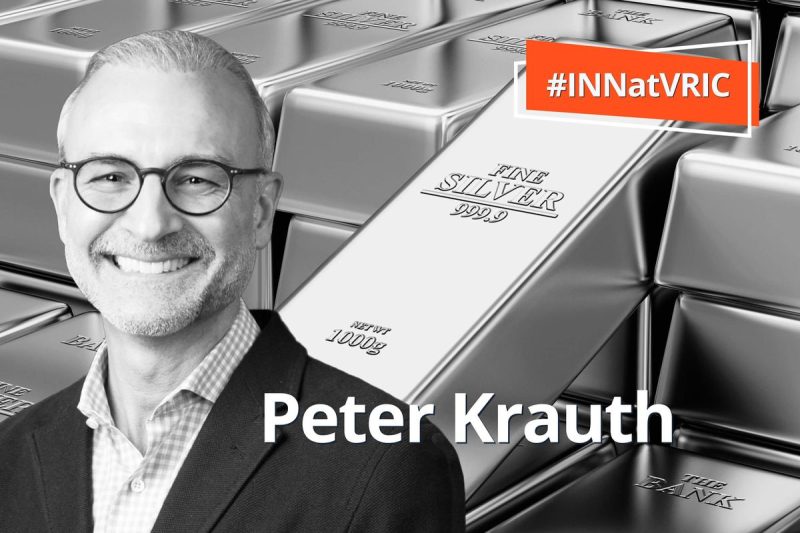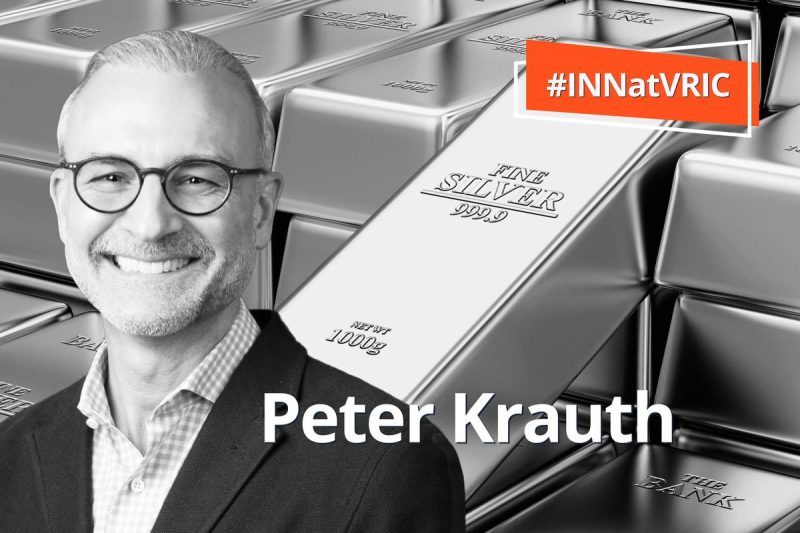
Since July 2020, the price of an ounce of silver has largely fluctuated between US$20 and US$26 per ounce, with a couple of exceptions. Where is the white metal headed in 2024 and beyond?
The use of silver in society dates back more than 5,000 years. First used to make jewelry and coins, it’s found more varied applications as time has gone by. While it still enjoys its position as a precious metal, it is increasingly finding important roles in the electronics industry and in the worldwide transition to renewable energy sources.
Speaking at this year’s Vancouver Resource Investment Conference (VRIC), Peter Krauth, editor of the Silver Stock Investor and author of ‘The Great Silver Bull,’ provided insight on what investors can expect from silver in the future.
Tide could be turning for the resource sector
The resource sector has seen little interest from retail investors over the past 10 years, which has contributed to an undervaluation in mining stocks. Krauth sees a change coming on that front, and said that with interest rate cuts looming, the global macroeconomic environment is beginning to shift to a more positive position for the sector.
He’s predicting a strong decade ahead for commodities, and said he views record low levels of investment from institutional entities as a strong contrarian indicator.
“There was a survey by Bank of America (NYSE:BAC), they looked at fund managers and asked them what their exposure was to commodities versus bonds, and we’re at the lowest point that we’ve been since March of 2009. So they’re the most underweight (right now) for commodities versus bonds,” he told the audience at the event.
Is there enough silver to meet demand?
Krauth is optimistic about silver in particular, noting that it has held up well in the face of aggressive rate hikes.
The metal’s supply/demand dynamics have helped to provide price support, with demand reaching record highs and mine supply shrinking. “Despite record demand in silver, we actually had a shrinkage of 18 million ounces last year in supply, that’s about 2 percent. The Silver Institute thought supply would actually be up,” he explained.
The biggest issue contributing to constrained silver supply is challenges that have limited producers’ ability to get the commodity out of the ground and to market, most notably in Latin America.
“Mexico, which is the world’s largest silver producer, was actually down 12 percent last year,’ Krauth said. ‘A lot of that has to do with Newmont’s (TSX:NGT,NYSE:NEM) Peñasquito mine, which was offline for four months due to a strike. Peru has actually seen its mine supply shrink for the last six or seven years. We’re down to levels we had 20 years ago.’
He doesn’t see that changing any time soon. There are a limited number of silver projects in development, including some in Russia that seem uncertain, and one in Bosnia and Herzegovina that Krauth said is likely to go ahead. The closest to production is Endeavour Silver’s (TSX:EDR,NYSE:EXK) Terronera in Mexico, which is expected to come online in late 2024.
But new mines will have a limited impact on the supply gap due to the relative scarcity of primary silver mines in the world. Seventy-five percent of the world’s silver is a by-product of mining gold, copper, lead and zinc. This puts silver in a tenuous situation if base metals operations face setbacks due to a recession or other economic instability.
So far, shortfalls have been made up by aboveground silver supply, but Krauth sees this as a problem. He pointed to the Silver Institute’s estimation that over the past three years silver has been in deficit by about 500 million ounces.
“Other than mining or recycling, you’ve got people who are perhaps selling their holdings back into the market. You could have some exchange-traded funds that hold silver going back into the market, you have people taking delivery on futures contracts,’ Krauth said during his talk. ‘If you add all that up, there is supply that is meeting demand, but nobody knows exactly what the aboveground supplies are — you’d have to assume a few billion ounces — but in three years, we’re up to half a billion ounces. So you’d have to imagine that can really only go on so long.’
Even though the silver market has posted deficits for the past three years, Krauth said 2023 saw a slight reduction in demand owing to declines in demand for jewelry, silverware and physical investment; however, he noted that these categories were essentially reverting to their mean following strong demand in 2022.
Krauth anticipates a bounce in demand in 2024 on increasing industrial usage. At the beginning of last year, the Silver Institute was forecasting demand growth of 4 percent for the industrial segment in 2023, but by November the organization had revised that forecast up to 8 percent, representing a record 632 million ounces.
“The industrial demand side is growing a lot,” he said. ‘I like to say that industrial demand provides a rising steady floor under the silver price, and when investment demand kicks in, that’s the wild card that helps to create these rallies and these spikes in the silver price. That’s what you really want to be exposed to.’
Silver’s growing role in the energy transition
Looking further out, Krauth said solar will be a driving force behind increasing industrial demand for silver. At the start of 2023, the Silver Institute predicted that demand from photovoltaics would reach 161 million ounces for the year, but in a revision in its November 15, Interim Silver Market Review report it indicated solar had accounted for 30 percent of 632 million ounces of industrial demand, equating to 191 million ounces, 30 million more ounces than originally forecast.
As new solar technologies with greater silver requirements come online, demand is only going to increase, even if sales remain flat.
“The most popular incumbent (solar) technology for the last several years has been something called PERC,’ he said. ‘Next in terms of energy output are TOPCon, which takes 50 percent more silver per panel, and then HJT, which takes up to 150 percent more silver per panel. Four years ago, the two newer technologies that took more silver represented 10 percent of the manufacturing capacity; last year, they already represented 35 percent of manufacturing capacity.’
Krauth believes the silver industry is at an inflection point — with new technologies being adopted quickly, demand for the white metal from industrial sources is going to increase dramatically over the next few years, especially against a backdrop of incentives from governments encouraging the installation of new solar capacity.
“If we’re talking only three years out, solar will be the world’s largest source of energy. It will surpass coal and natural gas. So really solar is absolutely taking over in many, many places as the cheapest form of new energy to add to your grid,” Krauth remarked.
In addition to its use in photovoltaics, Krauth drew attention to the possibility of silver replacing platinum-group metals as an anode material in hydrogen fuel cells, which could drive production costs down and potentially be adopted quickly.
He sees these industrial uses driving silver upward, and said a US$30 price point this year is not out of the question. More dramatically, during VRIC’s silver outlook panel, he suggested its price could climb to over US$300 by 2030.
When Krauth started his session at VRIC, he remarked that not 30 minutes before, a consortium of silver producers had announced it would be sending a letter to the government of Canada urging that silver be recognized as a critical mineral.
According to the letter, which was sent on January 31, silver has been left off the list because of a misconception about its availability. It speaks to many of the points Krauth made about the supply of the metal, especially around the energy transition. Being included on the list would allow silver producers to accelerate the development of strategic projects with financial and administrative assistance from the Canadian government.
The next update for the critical minerals list is expected in the summer of 2024.
Investor takeaway
With silver demand set to increase and supply not projected to keep up, plus a more positive macroeconomic environment, a perfect storm could be brewing for the silver market and for investors in the white metal.
But predictions of silver’s breakout have come before. Investors should keep that in mind when looking for opportunities in the market. There are no guarantees.
Securities Disclosure: I, Dean Belder, hold no direct investment interest in any company mentioned in this article.

